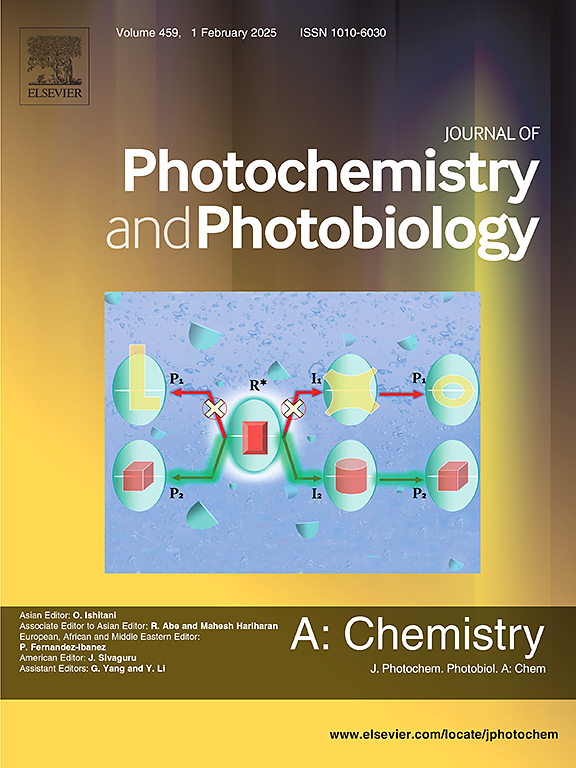TiO2负载铑铜光催化制氢研究
IF 4.7
3区 化学
Q2 CHEMISTRY, PHYSICAL
Journal of Photochemistry and Photobiology A-chemistry
Pub Date : 2025-05-23
DOI:10.1016/j.jphotochem.2025.116513
引用次数: 0
摘要
本文报道了溶胶-凝胶法合成的TiO2负载的Rh、Cu和Rh-Cu三种不同光催化剂的光催化制氢过程。采用尿素沉积沉淀法将Rh、Cu和Rh-Cu添加到TiO2上。甲醇、乙醇、异丙醇和甘油作为牺牲剂与水混合。分析了光催化剂在还原和氧化条件下的产氢情况。还报道了热处理和光催化剂质量的影响。采用SBET、UV-vis、XRD、HAADF-STEM-EDS、H2-TPR和XPS光谱对催化剂进行了表征。结果表明,1Rh-1Cu/TiO2光催化剂的产氢量为1212µmol/h,高于1Rh/TiO2(363µmol/h)和1Cu/TiO2(340µmol/h)光催化剂。甲醇是产氢的最佳牺牲剂,其次是乙醇、异丙醇和甘油。在还原性条件下预处理的光催化剂比在氧化性条件下预处理的光催化剂产氢率更高。相对于氧化态(Rh3+和Cu2+), Rh0和Cu0的存在促进了氢的析出。在紫外光照射下,还原态Ti3+的形成似乎对产氢没有影响。在还原物存在的情况下,观察到带隙能量的红移。在紫外光照射下,氧空位作为光致电子和空穴的复合中心,阻碍了氢的生成。在可见光下,氧空位可以作为电子给体,促进电荷的传递和分离,从而提高催化活性。本文章由计算机程序翻译,如有差异,请以英文原文为准。

Enhanced hydrogen production by Rh-Cu supported on TiO2 by the photocatalytic process
Hydrogen production by the photocatalytic process on three distinct photocatalysts containing Rh, Cu, and Rh-Cu supported on TiO2 synthesized by the sol–gel method is reported. The addition of Rh, Cu, and Rh-Cu onto TiO2 was performed by the deposition–precipitation with urea method. Methanol, ethanol, isopropanol, and glycerol were used as sacrificial agents in a mixture with water. Hydrogen production over the photocatalysts pretreated under reduced and oxidized conditions was analyzed. The impact of the thermal treatment and the photocatalyst mass is also reported. Photocatalysts were characterized by SBET, UV–vis, XRD, HAADF-STEM-EDS, H2-TPR, and XPS spectroscopy.
It was found that the 1Rh-1Cu/TiO2 photocatalyst produced the largest amount of hydrogen (1,212 µmol/h) with respect to the 1Rh/TiO2 (363 µmol/h) and 1Cu/TiO2 (340 µmol/h) photocatalysts. Methanol was the best sacrificial agent for producing hydrogen, followed by ethanol, isopropanol, and glycerol. The photocatalysts pretreated under reducing conditions boosted hydrogen production in comparison with the one pretreated under oxidizing conditions. The presence of Rh0 and Cu0 species enhanced the hydrogen evolution with respect to the oxidized species (Rh3+ and Cu2+). The formation of reduced Ti3+ species seemed to have no effect on hydrogen production under UV light irradiation. A red shift of the band gap energy was observed in the presence of reduced species. Under UV irradiation, the oxygen vacancies worked as recombination centers for the photo-induced electrons and holes, which hindered hydrogen production. By means of visible light, oxygen vacancies could act as electron donors, facilitating the charge transport and separation, which improved the catalytic activity.
求助全文
通过发布文献求助,成功后即可免费获取论文全文。
去求助
来源期刊
CiteScore
7.90
自引率
7.00%
发文量
580
审稿时长
48 days
期刊介绍:
JPPA publishes the results of fundamental studies on all aspects of chemical phenomena induced by interactions between light and molecules/matter of all kinds.
All systems capable of being described at the molecular or integrated multimolecular level are appropriate for the journal. This includes all molecular chemical species as well as biomolecular, supramolecular, polymer and other macromolecular systems, as well as solid state photochemistry. In addition, the journal publishes studies of semiconductor and other photoactive organic and inorganic materials, photocatalysis (organic, inorganic, supramolecular and superconductor).
The scope includes condensed and gas phase photochemistry, as well as synchrotron radiation chemistry. A broad range of processes and techniques in photochemistry are covered such as light induced energy, electron and proton transfer; nonlinear photochemical behavior; mechanistic investigation of photochemical reactions and identification of the products of photochemical reactions; quantum yield determinations and measurements of rate constants for primary and secondary photochemical processes; steady-state and time-resolved emission, ultrafast spectroscopic methods, single molecule spectroscopy, time resolved X-ray diffraction, luminescence microscopy, and scattering spectroscopy applied to photochemistry. Papers in emerging and applied areas such as luminescent sensors, electroluminescence, solar energy conversion, atmospheric photochemistry, environmental remediation, and related photocatalytic chemistry are also welcome.

 求助内容:
求助内容: 应助结果提醒方式:
应助结果提醒方式:


